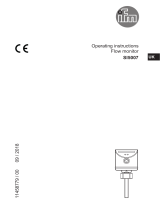
2
Contents
1 Preliminary note ���������������������������������������������������������������������������������������������������4
1�1 Symbols used ������������������������������������������������������������������������������������������������4
2 Safety instructions �����������������������������������������������������������������������������������������������4
3 Items supplied������������������������������������������������������������������������������������������������������5
4 Functions and features ����������������������������������������������������������������������������������������6
4�1 Applications ���������������������������������������������������������������������������������������������������6
4�1�1 Restriction of the application area ��������������������������������������������������������6
5 Function ���������������������������������������������������������������������������������������������������������������7
5�1 Measuring principle ���������������������������������������������������������������������������������������7
5�2 Features of the unit ����������������������������������������������������������������������������������������8
5�2�1 Easy set-up �������������������������������������������������������������������������������������������8
5�2�2 Display functions ����������������������������������������������������������������������������������8
5�2�3 Switching functions ������������������������������������������������������������������������������� 8
5�2�4 Offset for indicating the real level in the tank ����������������������������������������9
5�2�5 Probes for different tank heights� ����������������������������������������������������������9
5�2�6 Safe state ���������������������������������������������������������������������������������������������9
5�2�7 Binary mode ���������������������������������������������������������������������������������������10
5�3 IO-Link ��������������������������������������������������������������������������������������������������������� 11
6 Installation���������������������������������������������������������������������������������������������������������� 11
6�1 Installation location / environment ��������������������������������������������������������������� 11
6�2 Installation of the probe �������������������������������������������������������������������������������14
6�3 Shortening of the probe �������������������������������������������������������������������������������15
6�4 Installation of the unit �����������������������������������������������������������������������������������15
6�4�1 Installation in closed metal tanks (without flange plate) ���������������������16
6�4�2 Installation in closed metal tanks (with flange plate) ��������������������������16
6�4�3 Installation in open tanks ��������������������������������������������������������������������17
6�4�4 Installation in plastic tanks ������������������������������������������������������������������ 18
6�5 Alignment of the sensor housing �����������������������������������������������������������������18
7 Electrical connection ������������������������������������������������������������������������������������������19
8 Operating and display elements ������������������������������������������������������������������������20
9 Menu ������������������������������������������������������������������������������������������������������������������21
9�1 Menu structure / switching mode (bin = OFF) ���������������������������������������������21
9�2 Menu structure / binary mode (bin = on) ������������������������������������������������������22
9�3 Explanation of the menu ������������������������������������������������������������������������������23





















